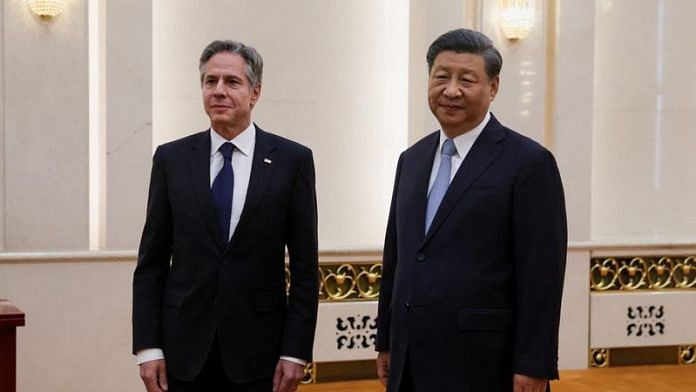Xi Jinping’s meeting with US Secretary of State Antony Blinken may have resulted in a temporary truce, but it is clear that the Chinese president wants stability in US-China relations on his own terms. Beijing’s actions during Blinken’s indicate that Xi isn’t conceding ground to the US at this time.
While signalling the need to stabilise relations, Xi told Blinken categorically that China will not allow the US to dictate Beijing’s choices through containment strategies like sanctions on Chinese companies and the formation of alliances such as the Quad. He reiterated China’s “legitimate right to development” and called on the US to stop trying to contain it. This position has been strengthened by previous restrictions imposed by both the Trump and Biden administrations on Chinese companies and their access to US technology.
Although Xi struck a conciliatory tone during the meeting, it is clear that he wants a truce on his own terms. He reassured Blinken that China “will not challenge or replace the United States”, a statement he had made previously. However, the consensus reached between the two sides during the G20 in Bali last year was derailed by the Chinese spy balloon incident.
Blinken assured the Chinese that the US is “de-risking and diversifying” its economy rather than seeking decoupling. The concept of ‘de-risking’ is out of the European playbook, but the White House aims to use it to reassure China while maintaining the sanctions regime against Chinese businesses. This strategy may bring some stability to the relationship, but it won’t make the presumption about each other’s intentions go away. Blinken isn’t the only one. “We can de-risk but not decouple,” said Greg Hayes, chief executive of Raytheon.
But the ‘de-risking’ strategy leaves room for interpretation as Beijing finds it difficult to believe that the US is not trying to ‘contain China’. China believes that the US wants to contain its economic rise, while the US believes China is seeking to replace its pre-eminence in international politics.
Beijing has already indicated that it finds the US and Europe’s ‘de-risking’ strategy unacceptable. While Blinken was in Beijing, Chinese Premier Li Qiang rejected the rhetoric of ‘de-risking’ or ‘reducing dependence’ on China during his visit to Germany.
“The root cause of the trough in Sino-US relations is that the US holds wrong perceptions of China and formulates wrong policies towards China,” said Yang Tao, director of the Department of United States and Ocean Affairs. Tao’s comment illustrates that Blinken’s reassurances can’t address Beijing’s lack of trust in Biden’s China strategy.
Also read: India is at frontline in US-China bipolar contest. It can’t afford to choose wrong partners
The truce won’t last long
Xi made it clear to Blinken that he wouldn’t make the US’ job easy. Beijing refused Blinken’s request to resume military-to-military contacts and establish a crisis line – the top agenda item of the visit. China likely wants to maintain its options for responding to US military presence in the South China Sea and the Taiwan Strait, and it aims to catch the US off guard during military operations. In recent weeks, the PLA has been seen conducting risky moves targeting US jets and naval vessels. This refusal to establish military contact shows Xi’s determination to push for engagement on his own terms.
During the meeting, Xi’s remarks conveyed a sense of exasperated calm. The camera angles deliberately shifted to show the entire room, rather than focusing solely on Xi, giving the impression that the US delegation was appearing before the imperial Chinese court rather than the leader of another modern nation-state.
Xi’s decision to sit on the table in a horseshoe formation was a departure from past conventions, where he sat across from past US Secretaries of State, suggesting his desire to assert his authority.
Xi’s meeting with Blinken was also in sharp contrast with his meeting with Bill Gates, whom he greeted with a friendly smile and sat next to him. This highlights Xi’s concerns about the political relationship with the US, while still showing respect for economic ties. China’s economic recovery remains dismal, and there are growing concerns that US restrictions on access to semiconductor technology could further hurt this recovery.
The US has done everything in its capacity to seek dialogue with Beijing. Blinken even hushed away the whole balloon fiasco. “That chapter should be closed,” he said before leaving Beijing.
Although Blinken’s visit achieved the primary goal of reopening dialogue and returning to the consensus reached in Bali, the fragile peace may not last long. Xi will continue to remind President Biden about his own terms for stability in the relationship.
Factors such as the upcoming visit of Prime Minister Narendra Modi to the US, which will likely rile Beijing despite Washington’s repeated attempts to downplay the China factor, as well as the US’ support for Taiwan’s self-defence capability and the issue of China’s influence in US elections next year, could all derail the truce once again.
If Xi Jinping is willing to uphold his side of the bargain for stability in economic relations, Blinken’s ‘de-risking’ rhetoric may actually spook him even more. The truce reached by Blinken between the US and China is unlikely to last long, as Xi has defined the terms of stability.
The author is a columnist and a freelance journalist. He was previously a China media journalist at the BBC World Service. He is currently a MOFA Taiwan Fellow based in Taipei and tweets @aadilbrar. Views are personal.
(Edited by Prashant)



